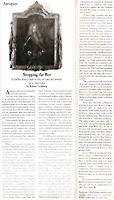|
|||||||||||||||||||||||||||||||||||||||||||||||||||||||||||||||||||||||||||||||||||||||||||||||||||||||||||||||||||||||||||||||||||||||||||||||||||||||||||||||||||||||||||||||||||||||||||||||||||||||||||||||||||||||||||
| THE
GUILD IN THE PRESS
By Robert Goldberg Antiques and art lead a hard life in South Louisiana. You can easily observe the effects of geography and climate on the decaying exterior weatherboards and mildewed paint of our homes, and just keeping the doors and windows closed and turning down the air conditioning will not guarantee that your precious furniture, paintings, books, textiles and rugs will survive over time. Since antiques, by definition, have been around for a while, quietly and insidiously, humidity, mold and mildew accompanied by legged and winged creatures, roaches, mice, termites and moths, have infiltrated your protective barriers and continued their naturally assigned task of devouring your possessions. What can you do to repair the damage? Thankfully, there are trained individuals, called conservators, who can often restore the damage done by nature and vermin. New Orleans is fortunate to have a community of talented and trained professionals. They have been attracted by the active market in antiques and art, coupled with the decaying state of the indigenous artifacts, which create abundant work. In 1997, Blake Vonder Haar, a conservator trained in the European apprentice system in Florence, Paris and London, visited New Orleans. Vonder Haar was so taken with the place that, after researching the need for conservation services, the St. Louis moved here from Cape Town, South Africa. Three years later, her New Orleans Conservation Guild, located in a large two-story antique weatherboard building in New Orleans' Bywater section, has a complement of artisans restoring and conserving paintings, frames, works on paper, glass, ceramics, wood and furniture. The client list has expanded to include museums in Europe and the U.S., out-of-town individuals and collectors as well as numerous clients from our region. The Guild also offers art research services, documenting provenance, identifying the artist and sitters, and developing market analysis for owners considering the sale or purchase of works. Assembling the talented staff has been a daunting task for Vonder Haar, the supervising conservator. "You don't find trained conservators just walking down the streets of New Orleans," she said. "These individuals have degrees in fine arts, art history and design and training in conservation and conservation science." In the warehouse, I could not miss an enormous French oil painting from about 1710 hanging on the first floor, depicting a bewigged military commander dressed in armor. This painting, which is destined to be displayed in the soon-to-open Ritz Carlton Hotel on Canal Street, came in to the Guild in terrible condition. The massive gilt wood frame, carved with a baldachin crest, military trophies, drapery, tassels, spears and ribbons, had fallen during its lifetime and lost some elements. Layers of soot discolored the gilding. It was a wreck - 120 hours were required to dismantle and clean it, stabilize the loose ornaments, replace the lost elements and gild the frame to return it to its former glory. Vonder Haar considers the most challenging project undertaken by the Guild to be the restoration of the Ferdinand Martin City Park mural, which had been a feature of the building housing Peristyle, the renowned French Quarter restaurant destroyed by fire last year. Martin is believed to have been a New Orleans sign painter and artist who worked in the early part of the twentieth century. He is best known for his murals of City Park. The Peristyle mural was beloved by the restaurant's patrons but had been poorly maintained, exhibiting many creases and holes. The fire caused more deterioration. Despite a modest budget, the Guild removed the mural from the burned-out restaurant and struggled mightily to save it and bring it back to life. The Guild has reinstalled the mural, and now diners at Peristyle can enjoy the splendid decorative artwork while they savor the marvelous cuisine. The conservation and restoration of art and antiques is not inexpensive; it is possible for the cost of restoration to exceed the market value of an object. But if you have something that means a lot to you or touches you emotionally, the price of bringing it back to life may seem reasonable. Years ago, when the gilding on antique mirror and picture frames became dull or darkened, the handyman of the family would visit the hardware store to buy a can of his favorite radiator paint. The choices for the "restoration" were silver or bronze. The radiator paint was great stuff. It wore well, covered the original gilding and didn't chip. Well, here we are at the start of the twenty-first century, and those antique frames with their radiator paint finishes intact are still coming through the door of the New Orleans Conservation Guild. Unfortunately their true restoration requires the time-consuming removal of the handyman finish before getting down to the serious work. If you inherit an antique painting, mirror, statue or table that seems to need some freshening and the urge to do it yourself comes over you, stop yourself. Don't reach for the bondo or radiator paint. Consult with a conservator. You have a responsibility to maintain these objects for posterity. And you might just be tampering with history. If you are interested in contacting the New Orleans Conservation Guild, you can call for an appointment at (504) 944-7900. |
| Back to the NOCG press page |
Contact us
for more information: Phone: (504)
944-7900 |

 Stopping the Rot
Stopping the Rot